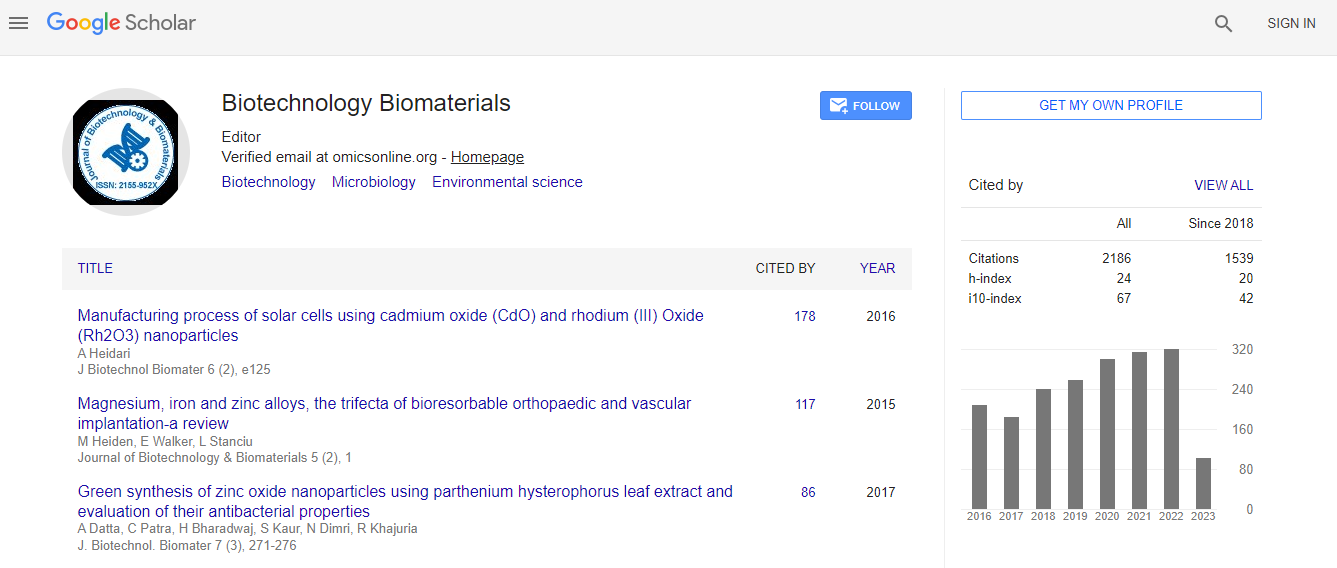Our Group organises 3000+ Global Conferenceseries Events every year across USA, Europe & Asia with support from 1000 more scientific Societies and Publishes 700+ Open Access Journals which contains over 50000 eminent personalities, reputed scientists as editorial board members.
Open Access Journals gaining more Readers and Citations
700 Journals and 15,000,000 Readers Each Journal is getting 25,000+ Readers
Google Scholar citation report
Citations : 3330
Journal of Biotechnology & Biomaterials received 3330 citations as per Google Scholar report
Indexed In
- Index Copernicus
- Google Scholar
- Sherpa Romeo
- Open J Gate
- Genamics JournalSeek
- Academic Keys
- ResearchBible
- China National Knowledge Infrastructure (CNKI)
- Access to Global Online Research in Agriculture (AGORA)
- Electronic Journals Library
- RefSeek
- Hamdard University
- EBSCO A-Z
- OCLC- WorldCat
- SWB online catalog
- Virtual Library of Biology (vifabio)
- Publons
- Geneva Foundation for Medical Education and Research
- Euro Pub
- ICMJE
Useful Links
Recommended Journals
Related Subjects
Share This Page
Development of an in vitro testing battery to assess biocompatibility of medical devices
2nd Annual Conference and Expo on BIOMATERIALS
Elisabeth Mertl, Gabriele Ettenberger, Christian Kirchnawy, Magdalena Haller, Daniela Neubert and Thomas Czerny
OFI Technology & Innovation GmbH, Austria University of Applied Sciences, Austria
Posters & Accepted Abstracts: J Biotechnol Biomater
Abstract
In order to guarantee safety for the end-users of medical devices, they have to be tested for adverse reactions on the skin before market authorization. Animal testing is still state of the art, but ethically questionable and expensive. During the last years, socio-political pressure has led to the development of alternatives. One of the key aspects of our recent research is to establish an in vitro testing battery to examine the biocompatibility of medical devices in contact with the skin or mucosa. The first task was the development of an appropriate extraction method in order to cover a wide range of substances migrating from the device. As skin models and various assays have already been developed for testing pure chemicals, the focus was on the establishment of such methods to assess extracts for cytotoxicity, irritation and sensitization. To identify a possible sensitization potential, a screening method to cover different steps of the skin sensitization process was developed. The molecular initiation event, the binding of haptens to peptides can be assessed by chromatographic methods. The molecular and cellular responses include the activation of an antioxidant pathway in keratinocytes and hence, activating the phenotypical deformation of dendritic cells. So far, various samples have been examined in the different assays. Spiking of sample extracts was used to prevent false negative results. Additionally, samples were examined with animal testing in order to compare the results which showed more sensitive responses in the in vitro assays. Further, it could be shown that not only materials themselves but also the manufacturing process plays an important role for biocompatibility. In this context, production processes of medical devices were improved. Summarizing, these assays are developed not only with a sufficient sensitivity, but also to be robust, simple to use, ethically responsible and inexpensive in comparison to current animal testing.Biography
Email: elisabeth.mertl@ofi.at

 Spanish
Spanish  Chinese
Chinese  Russian
Russian  German
German  French
French  Japanese
Japanese  Portuguese
Portuguese  Hindi
Hindi 
